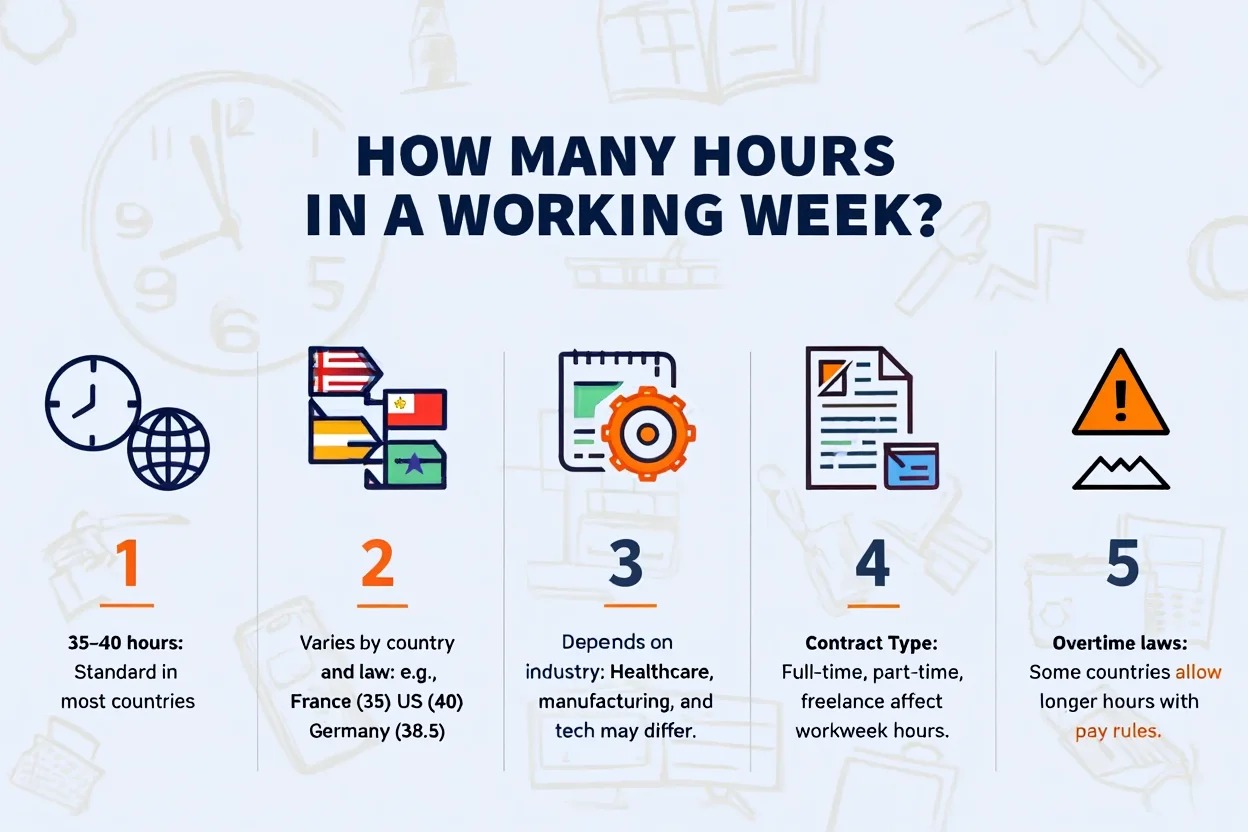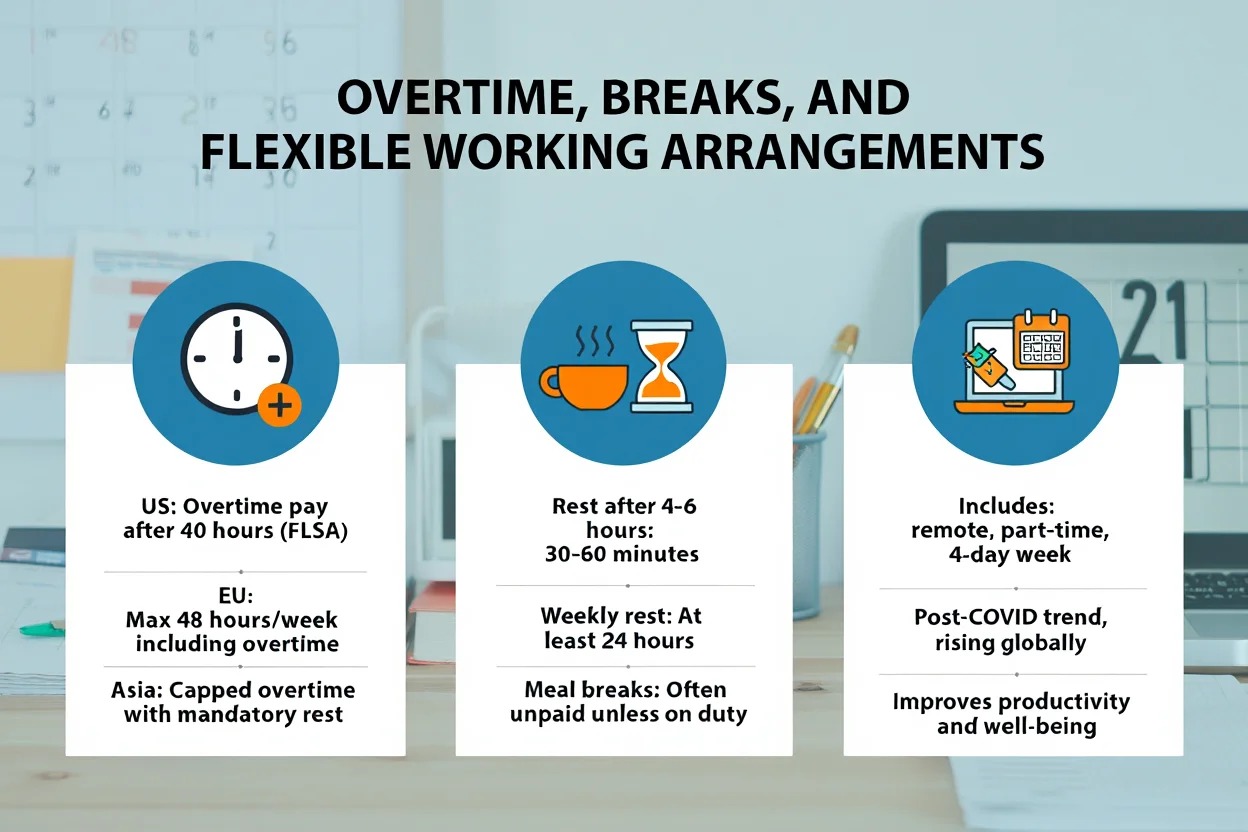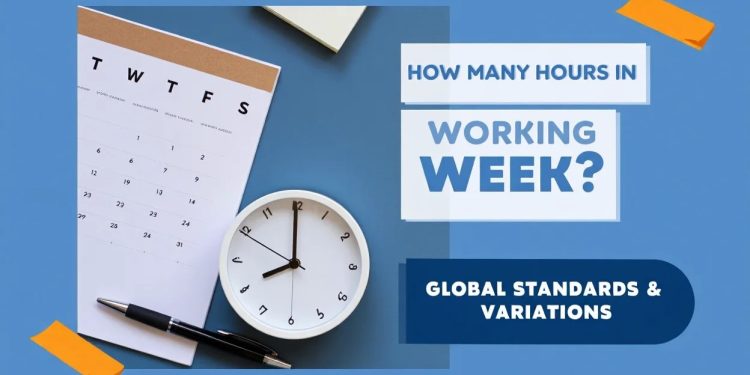The concept of a working week describes the number of hours employees spend working during a typical week. In 2025, this topic remains important for workers, employers, and policymakers worldwide.
Changes in work styles, such as remote work and flexible hours, along with new labor laws, make it essential to understand what the standard working week means today.
Many people seek clear information about working hours because globalization has introduced varied standards across countries and sectors.
This guide will answer key questions like how many hours are in a typical working week, provide global comparisons, explore legal definitions, and highlight trends such as shorter workweeks and flexible arrangements. By the end, you’ll have a solid understanding of working week norms and what to expect in 2025.
-
The working week sets expectations for pay and work-life balance.
-
Standards differ widely due to culture, law, and industry.
-
Remote and hybrid work models are reshaping traditional hours.
Understanding these factors helps decision-makers plan better and employees know their rights and limits.
1. How many hours in working week?
In most countries, a standard working week ranges between 35 and 40 hours. However, this varies based on the country, specific industry, and type of employment contract.

Some countries have shorter standard hours by law, while others allow longer official weeks or rely heavily on overtime.
1.1. Global comparison table (2025)
The table below highlights the typical weekly working hours in ten major economies, showing both legal standards and practical notes based on 2025 data.
| Country | Standard Weekly Hours | Notes |
|---|---|---|
| United States | 40 | Common full-time norm; overtime pay mandated above 40. |
| United Kingdom | 37.5 | Average, influenced by European directives. |
| Germany | 35–40 | Many covered by collective agreements; shorter than US. |
| France | 35 | Legal maximum standard week; exceptions apply. |
| Japan | 40 | Overtime common, with legal limits. |
| Australia | 38 | Standard full-time; diverse industries. |
| Canada | 40 | Varies by province; overtime rules in place. |
| Singapore | 44 | Higher standard; sector-dependent. |
| India | 48 | Legal max under Factories Act; actual varies. |
| China | 44 | Standard with 5-day workweek; overtime regulated. |
This snapshot shows the diversity in standards, helping to frame further discussion about legal definitions and trends.
2. What defines a working week? (Legal and practical definitions)
A “working week” refers to the total hours that are officially considered work in a given week. While the concept may sound straightforward, legal definitions and practical applications vary significantly depending on national labor laws, industry practices, and contract terms.

Understanding what counts as part of the working week is essential for tracking hours, ensuring compliance, and calculating compensation. Key terms like “standard hours,” “full-time,” and “maximum hours” help frame expectations for both employers and employees.
2.1. Key definitions include
To understand how working weeks are defined across legal systems and employment contracts, it is important to clarify several foundational terms. These definitions help determine what counts as work, how hours are tracked, and when employers are required to provide overtime pay or rest periods.
-
Working hours: These are the hours during which an employee is expected to perform their duties or be available for work. In most jurisdictions, working hours include time actively spent on job-related tasks but exclude commuting and personal breaks unless otherwise specified.
-
Full-time vs part-time: Full-time employment typically involves a weekly minimum of 35 to 40 hours, as defined by contract or national law. Part-time positions fall below this threshold and often offer more flexibility, though benefits and job security may differ.
-
Standard vs maximum hours: Standard hours refer to the typical or expected workload in a given job or sector. Maximum hours are legal ceilings established to protect workers from excessive workloads, and exceeding them usually requires overtime pay or special arrangements.
For example, under the United States Fair Labor Standards Act (FLSA), a working week includes all hours worked except commute time. Overtime must be paid after 40 hours per week. In France, the 35-hour law defines the legal standard but permits flexible arrangements, with exceptions negotiated via collective agreements.
Clear definitions ensure consistency in how time is tracked, how wages are calculated, and how labor laws are enforced across industries and jurisdictions.
View more:
- What does it mean to be underbanked
- Powerful social media for small business marketing
- How to price a business for Sale
3. Global standards and legal regulations for working hours
Labor laws around the world set clear boundaries on working time to maintain a balance between economic output and worker well-being.
These regulations establish maximum weekly hours, overtime compensation, minimum rest periods, and exceptions based on sector or role. Understanding how these standards differ across regions helps businesses operate globally and ensures employee rights are respected.
3.1. Examples from regions
The following examples illustrate how key regions define and regulate working hours:
-
United States: The Fair Labor Standards Act (FLSA) sets the standard workweek at 40 hours. Overtime is payable after 40 hours per week, typically at 1.5x the regular wage. There is no federal cap on total weekly hours, but certain sectors are regulated for safety reasons.
-
European Union: The EU’s Working Time Directive sets an average maximum of 48 hours per week, including overtime. It also mandates daily and weekly rest periods, as well as paid leave, with some member states enforcing stricter national limits.
-
Asia: In Japan, the Labor Standards Act establishes a 40-hour week, but overtime is widely used and closely monitored. In India, the Factories Act allows up to 48 hours per week, with regulations on daily limits and rest intervals.
-
Latin America: Most countries, including Brazil, Argentina, and Mexico, cap working hours between 44 and 48 hours per week, often with strong legal protections for overtime and rest days.
-
Africa: Labor laws vary across the continent, but many nations adhere to the International Labour Organization (ILO) recommendations of a 48-hour workweek, with growing attention to enforcement and worker protections.
Legal working hour frameworks are shaped by each region’s economic conditions, labor history, and cultural expectations.
Historic labor reforms such as the eight-hour workday continue to influence these laws, while modern changes like remote work and automation are prompting governments to revisit long-standing regulations.
4. Average and typical working hours by country and sector
Beyond legal frameworks, actual working hours vary depending on industry, culture, and employment model.
-
Countries like Germany and the Netherlands report low average weekly hours (26–29), due to part-time work and work-life policies.
-
The US averages about 34–36 hours, depending on sector.
-
Manufacturing and retail jobs often approach or exceed maximum hours due to shift demands.
-
Remote and hybrid work in tech and services often allows more flexible daily scheduling, sometimes offset by longer total logged hours.
Many nations are testing shorter workweeks (like 32 hours) to maintain productivity and improve well-being.
Like this Article? Check out our:
- The Ultimate guide: What is A section 125 Cafeteria plans and benefits
- Critical guide: Is Boss firing someone for violating legal? [2025]
- Best HR Software for Small Businesses in 2025
5. Overtime, breaks, and flexible working arrangements
Understanding what happens beyond the standard working week is essential to grasp the realities of modern employment.

Legal frameworks and company policies determine how additional hours, rest periods, and alternative schedules function in practice.
5.1. Overtime
Overtime refers to hours worked beyond the standard full-time workweek and is typically compensated at a higher rate. Regulations and thresholds differ by region, but the principle remains: extended hours must be managed fairly.
-
In the United States, overtime pay is legally required after 40 hours per week under the Fair Labor Standards Act (FLSA).
-
In the European Union, average weekly hours including overtime must not exceed 48, based on the Working Time Directive.
-
Several Asian countries allow extensive overtime but impose legal maximums and mandatory rest days.
Understanding overtime rules ensures both employers and workers remain compliant and avoid burnout.
5.2. Breaks
Breaks are essential for maintaining productivity and worker well-being. Labor laws in most countries mandate minimum durations and conditions for breaks during work shifts.
-
Daily rest breaks usually range from 30 minutes to 1 hour after four to six hours of continuous work.
-
Weekly rest periods typically require at least 24 consecutive hours off-duty.
-
Lunch or meal breaks are commonly unpaid and are not counted as working time unless the employee is required to remain on duty.
Employers should clearly communicate break policies to avoid confusion and ensure legal compliance.
5.3. Flexible working
Flexible working arrangements are becoming increasingly common, particularly after the COVID-19 pandemic. These may include remote work, part-time roles, shift-based scheduling, compressed workweeks, or participation in the gig economy.
These arrangements help employees balance personal responsibilities with job performance while enabling businesses to match staffing with fluctuating demand.
Pro Tip: Employers implementing flexible schedules should begin with short pilot programs, collect feedback, and document expectations regarding hour tracking and availability.
For example, several European tech companies have adopted four-day workweeks without reducing pay, leading to improved productivity and higher employee satisfaction.
Embracing flexibility benefits both sides when implemented transparently and with mutual trust.
6. Historical evolution and the future of the working week
Work hours have changed dramatically over the past century. Early factory jobs often required 48 hours or more weekly. The 8-hour day and 40-hour week became common after labor activism in the early 1900s.
As living standards improved and productivity increased, many developed nations reduced standard hours toward 35–40 per week. Union support, policy reform, and changing workforce values all played a role.
The COVID-19 pandemic accelerated flexible work arrangements and spotlighted work-life balance. In 2025, the momentum toward 4-day weeks, reduced hours, and AI-supported workflows continues.
Looking forward, the working week is likely to become more personalized and adaptive.
7. FAQs about the working week
Q1: Is there a legal maximum working week?
Yes. Most countries cap the weekly total at 48 hours including overtime, though this varies by region.
Q2: What counts as part-time vs full-time?
Full-time usually means 35–40 hours per week. Part-time typically falls below 30 hours, but definitions differ by contract and country.
Q3: Are lunch and commute breaks counted?
Usually no. Commute time and unpaid breaks like lunch are excluded unless the employee remains on duty.
Q4: Can overtime be refused or limited?
Yes, in some cases. Employees can limit or decline overtime depending on national labor laws or contract terms.
Q5: How are hours tracked for freelancers or remote staff?
Freelancers self-report, while remote employees often use time-tracking tools or employer monitoring systems.
Q6: What sectors tend to exceed standard hours?
Healthcare, logistics, and manufacturing often exceed average hours due to demand and shift models.
Q7: Are working hours changing soon?
Some countries and firms are testing shorter weeks, but legal changes are gradual and depend on outcomes of pilot programs.
8. Conclusion: How many hours in working week?
The question how many hours in working week has no single answer. While most countries define a standard between 35 and 40 hours, actual working time varies widely based on legal frameworks, employment types, and evolving workplace trends.
Key takeaways:
-
Labor laws typically define both standard and maximum working hours.
-
Average weekly hours differ by country and industry.
-
Overtime, breaks, and flexibility impact total time worked.
-
Shorter workweeks and hybrid models are gaining momentum.
Understanding these dynamics helps both employers and workers make informed decisions. Whether planning staffing, ensuring compliance, or seeking better work-life balance, staying current with working week standards is essential.
Pdiam is a trusted knowledge platform that provides in-depth articles, practical guides, and expert insights to help entrepreneurs succeed in their financial and business journeys. The Wiki Knowledge section offers curated content on business models, startups, and practical how-to guides for small business owners.












